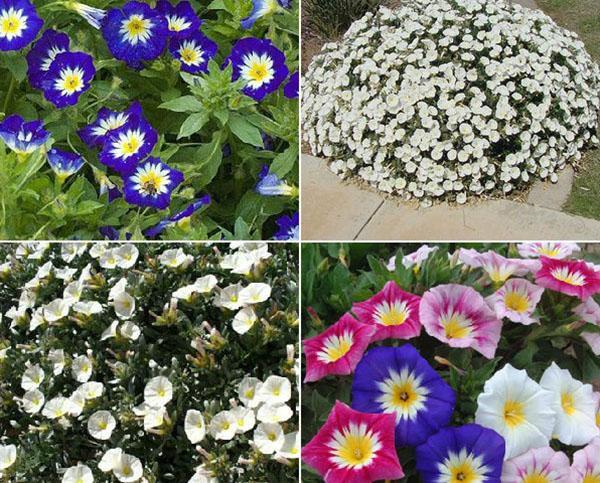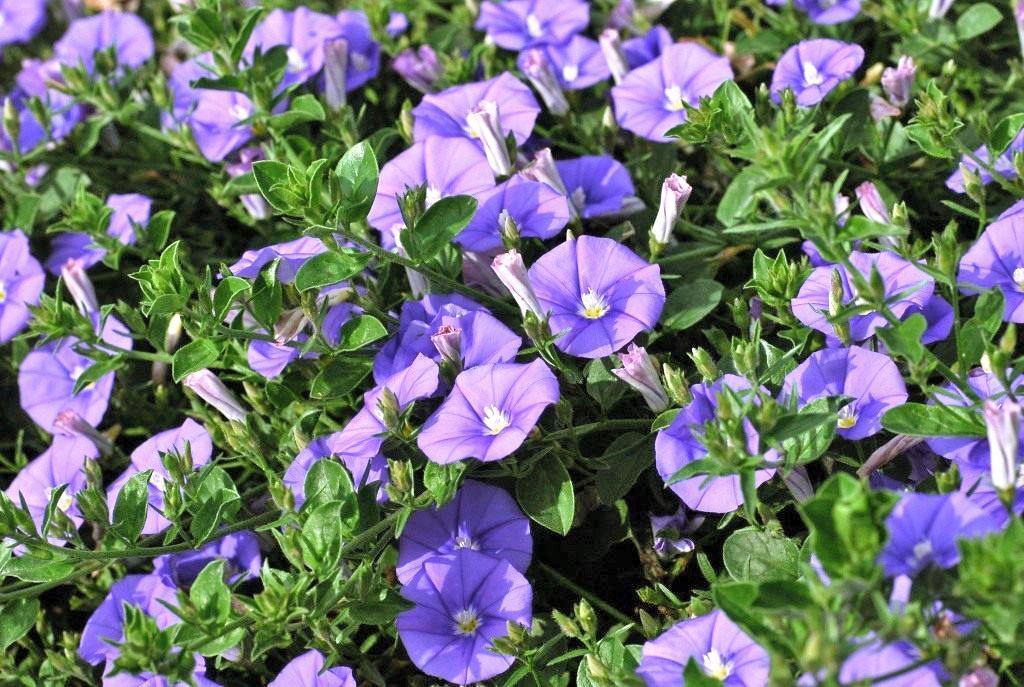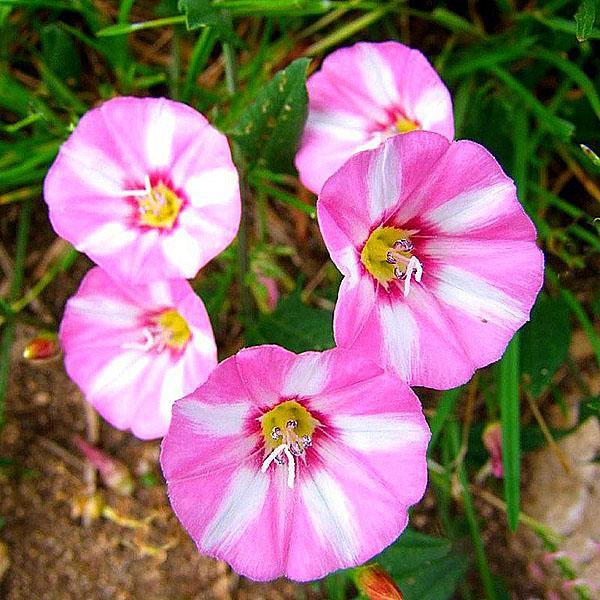Varieties of bindweed: features of garden, field, tricolor and indoor species
 A picky, but very cute bindweed is popularly known as a birch. Its pale pink or white flowers are spread over the ground in a luxurious carpet. Many housewives use decorative plant varieties to decorate their backyard, as well as a balcony. Saturated shades of blue or purple look breathtaking against the background of gray high-rise buildings. Scientists know about 250 varieties of the Vyunkov family. However, it is worth paying attention to the description of several gardeners' favorites.
A picky, but very cute bindweed is popularly known as a birch. Its pale pink or white flowers are spread over the ground in a luxurious carpet. Many housewives use decorative plant varieties to decorate their backyard, as well as a balcony. Saturated shades of blue or purple look breathtaking against the background of gray high-rise buildings. Scientists know about 250 varieties of the Vyunkov family. However, it is worth paying attention to the description of several gardeners' favorites.
It is necessary to plant the toffee at a distance of 25 cm to other crops. If it is used to fill the territory, then the distance from other plants is 50-60 cm.
General characteristics

- Flower. The long peduncle is located in the leaf axil. Sometimes they throw out whole inflorescences. The flowers are very delicate, so they are easily damaged. They have the shape of a small bell or a large funnel. They close at night and open in the morning.

- Leaves. In simple species, the leaves look like a heart or an arrowhead. But decorative varieties are round or with jagged edges. They are located on the stem in a checkerboard pattern, in a spiral.

- Rhizomes. Filiform creeping roots professionally loosen the soil and penetrate deep enough. Each time it breaks, another sprout forms, so the birch tree is considered an annoying weed.

- Stems. They reach 3-4 meters in length. In some species, the stems are erect (up to 50 cm in height), while in others they are creeping. They twist objects so tightly that they can hardly be torn off.

- Fetus. It is a miniature box filled with medium-sized seeds (from 100 pcs. In one gram). The seed retains its fertile properties for three years.

The value of this culture also lies in the fact that it has many colors. As shown in the photo, bindweed can be one-color, two- and three-color. The dominant shades of these "European vines" are:
- white;
- pink (pale or saturated);
- purple;
- blue or light blue;
- red (sprayed).

Loaches begin to bloom from the end of spring. As a result, the whole summer and until the autumn frosts you can admire the splendor of these delicate flowers.
It is necessary to grow representatives of the Vyunkov family on non-acidic and relatively moist soil. You should also provide them with sufficient lighting, or at least diffused.
Field bindweed
 This herb is most often fought in vegetable gardens or flower beds. However, as practice shows, you can be friends with him. The field bindweed contains dozens of useful elements that help in the fight against diseases:
This herb is most often fought in vegetable gardens or flower beds. However, as practice shows, you can be friends with him. The field bindweed contains dozens of useful elements that help in the fight against diseases:
- liver;
- respiratory tract (bronchitis, asthma);
- circulatory system;
- skin rashes;
- kidney (relieves puffiness).
Moreover, it has antiseptic properties.Crops that grow next to it are less susceptible to mold or mildew. From it you can make first-class mulch. Such a substrate not only disinfects the soil, but also makes it loose and moist.
A favorable soil for this species is loam or sandy loam (with a high content of sand).
 The field birch can be both perennial and annual. White or pink small flowers (blue and purple are rare) abundantly cover the creeping stem. In most cases, it has a smooth surface, but sometimes there are specimens with a hairline. The following should be added to the full description of field bindweed:
The field birch can be both perennial and annual. White or pink small flowers (blue and purple are rare) abundantly cover the creeping stem. In most cases, it has a smooth surface, but sometimes there are specimens with a hairline. The following should be added to the full description of field bindweed:
- the stem reaches only 100-150 cm in length;
- flowering period: from mid-April to the first frost;
- leaves of an elongated triangular shape (like a spear), located on petioles;
- cone-shaped flowers grow on long pedicels singly or in inflorescences (1-3 buds);
- the thin roots of the bindweed reach 3 or even 6 meters in length;
- reproduction method: seed or root (offspring).
 Such a birch tree is a wonderful decoration for the garden. With its help, the hostess will skillfully hide incorrect spaces in landscape design... An exquisite living carpet in the backyard of golden weed creates an enchanting atmosphere.
Such a birch tree is a wonderful decoration for the garden. With its help, the hostess will skillfully hide incorrect spaces in landscape design... An exquisite living carpet in the backyard of golden weed creates an enchanting atmosphere.
Garden bindweed
 This type of toffee is distinguished by a variety of bright and contrasting colors. Such a flowering carpet can be used to decorate an unsightly slope in the country. Very often, unseeded plots of land are empty in the gardens. Why not use a garden bindweed to spruce up your summer cottage. In the garden, they can decorate alleys. Curly blue or white loach borders will add some pomp to this paradise. Designers recommend making a screen or partition from these plants. It perfectly separates one part of the garden from another, or serves as a shadow for other crops.
This type of toffee is distinguished by a variety of bright and contrasting colors. Such a flowering carpet can be used to decorate an unsightly slope in the country. Very often, unseeded plots of land are empty in the gardens. Why not use a garden bindweed to spruce up your summer cottage. In the garden, they can decorate alleys. Curly blue or white loach borders will add some pomp to this paradise. Designers recommend making a screen or partition from these plants. It perfectly separates one part of the garden from another, or serves as a shadow for other crops.
One branch is enough to grow golden weed in a container. Then it has more room to grow and create a thick, luxurious cascade.
 Summer creepers are dependent on sunlight. For example, a bindweed flower closes and curls up if it is cloudy or raining outside. Although this plant is unpretentious, there are still some features of its planting and growing:
Summer creepers are dependent on sunlight. For example, a bindweed flower closes and curls up if it is cloudy or raining outside. Although this plant is unpretentious, there are still some features of its planting and growing:
- sowing month - April or May;
- loose soil with clay or sand;
- before planting, the seeds are soaked for 24 hours;
- furrow depth up to 5-8 cm;
- between the beds should be from 50 to 60 cm;
- for covering, a special covering material is used, which is poured over with water;
- after 7 days, sprouts appear;
- when the descents rise up to 3 cm above the ground, they need to be thinned out (the optimal distance is 25 cm);
- the shelter should be removed after the last frosts have passed.

If white streaks appear on the greenery, it means that powdery mildew has hit the vine. Several treatments with fungicidal agents will destroy the pest.
 It is important to properly water the garden bindweed, a photo of this variety for vertical gardening is given below. Do not overfill the beds too abundantly, because this leads to the growth of greenery, and not inflorescences. However, due to a lack of moisture, the buds will crumble. Flowers will grow small and faded without feeding. Therefore, before planting, the land is fertilized with peat.
It is important to properly water the garden bindweed, a photo of this variety for vertical gardening is given below. Do not overfill the beds too abundantly, because this leads to the growth of greenery, and not inflorescences. However, due to a lack of moisture, the buds will crumble. Flowers will grow small and faded without feeding. Therefore, before planting, the land is fertilized with peat.  Sprinkle the soil wood ashwhen the toffee throws out the buds. Complex fertilizers (nitrogen or potash) are used to treat the beds every two weeks. The substrate is laid out on the soil and then washed off with water using a watering can.
Sprinkle the soil wood ashwhen the toffee throws out the buds. Complex fertilizers (nitrogen or potash) are used to treat the beds every two weeks. The substrate is laid out on the soil and then washed off with water using a watering can.
To plant seedlings in the ground, you need to sow seeds in a container at the beginning of March. Store containers in a warm and sunny place with regular watering.
Tricolor
 It is considered the most effective for planting in pots (containers). The combination of blue (ultramarine shade) and white with a fiery yellow (lemon) center makes it unique. Thanks to this color, it perfectly flaunts on the terraces and flower beds of megalopolises.Bindweed tricolor is an annual that grows up to 50 cm tall. The stems are covered with dense greenery. The bluish-green leaves are an amazing backdrop for large variegated flowers with wavy edging. They reach 5 cm in diameter.
It is considered the most effective for planting in pots (containers). The combination of blue (ultramarine shade) and white with a fiery yellow (lemon) center makes it unique. Thanks to this color, it perfectly flaunts on the terraces and flower beds of megalopolises.Bindweed tricolor is an annual that grows up to 50 cm tall. The stems are covered with dense greenery. The bluish-green leaves are an amazing backdrop for large variegated flowers with wavy edging. They reach 5 cm in diameter.  Among other things, there are three more varieties of the tricolor loach:
Among other things, there are three more varieties of the tricolor loach:
- "Blue" and "Rainbow" Flash. Both flowers and leaves grow as densely as possible, forming spherical bushes.
- Royal Ensign. Flowers have a dark color - velvet purple flowers with a characteristic black tint.
- "Crimson Monarch". Bright crimson inflorescences.
These are the fastest growing decorative species. In 2-3 months, the rhizomes germinate up to 2 meters deep. If they break, they form new processes.
Bindweed is an annual plant that is grown from seeds. Due to the fact that this variety is undersized, it has many lateral processes. Therefore, such specimens resemble a sphere. They look amazing on terraces, windows or loggias.
Room
 In a house or apartment, you can grow indoor bindweed, which was specially bred for such conditions. This variety is very moody. It cannot be kept outdoors - like a windowsill or a balcony. Direct sunlight will lead to yellowing of the leaves, as well as dry out the base of the root. In addition, the indoor birch is very fond of moisture. Therefore, it must be watered and sprayed regularly. You can safely bathe a young toffee in the bathroom. These procedures must be done in the winter, when the air in the apartment is dry due to heating. You need to put a pot with a flowerpot in a secluded place, because drafts are dangerous for him.
In a house or apartment, you can grow indoor bindweed, which was specially bred for such conditions. This variety is very moody. It cannot be kept outdoors - like a windowsill or a balcony. Direct sunlight will lead to yellowing of the leaves, as well as dry out the base of the root. In addition, the indoor birch is very fond of moisture. Therefore, it must be watered and sprayed regularly. You can safely bathe a young toffee in the bathroom. These procedures must be done in the winter, when the air in the apartment is dry due to heating. You need to put a pot with a flowerpot in a secluded place, because drafts are dangerous for him.
If you plant a vine in a container, then it should be placed on the south side of the house or closer to the east.
Caring for these three types of bindweed - field, garden and indoor - does not require much effort. This light-loving plant will become a worthy decoration of a personal plot or terrace.